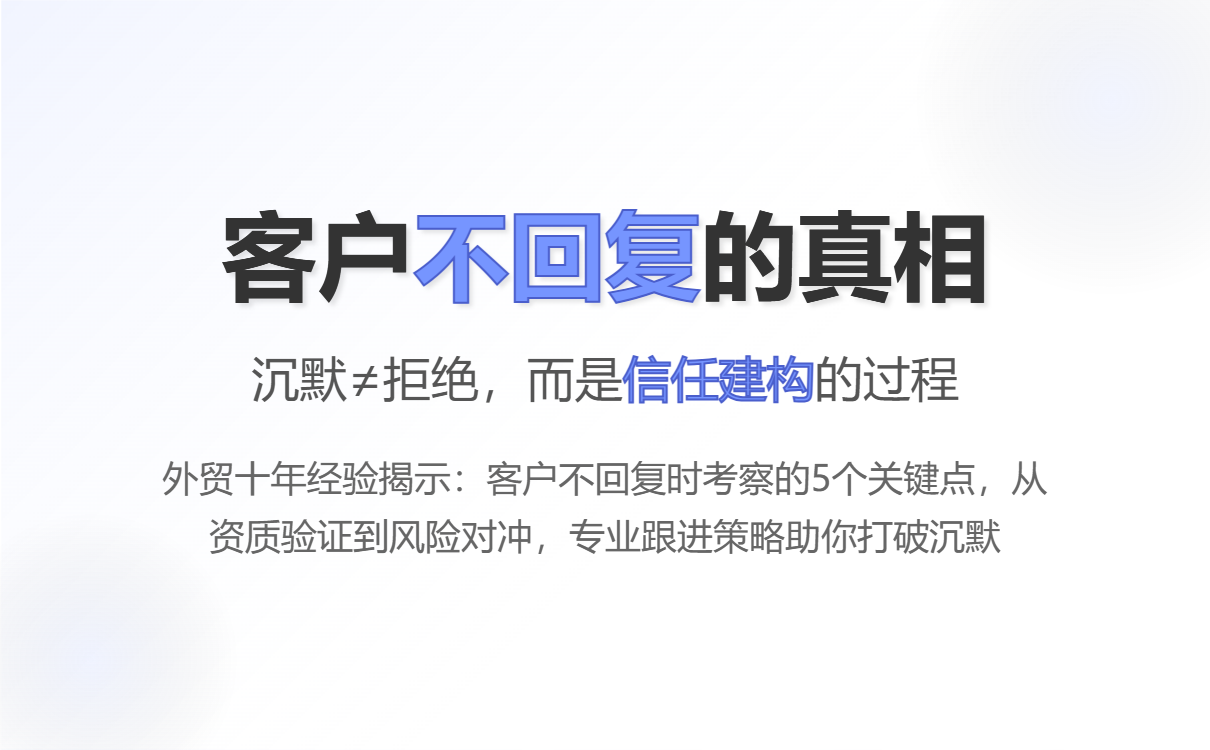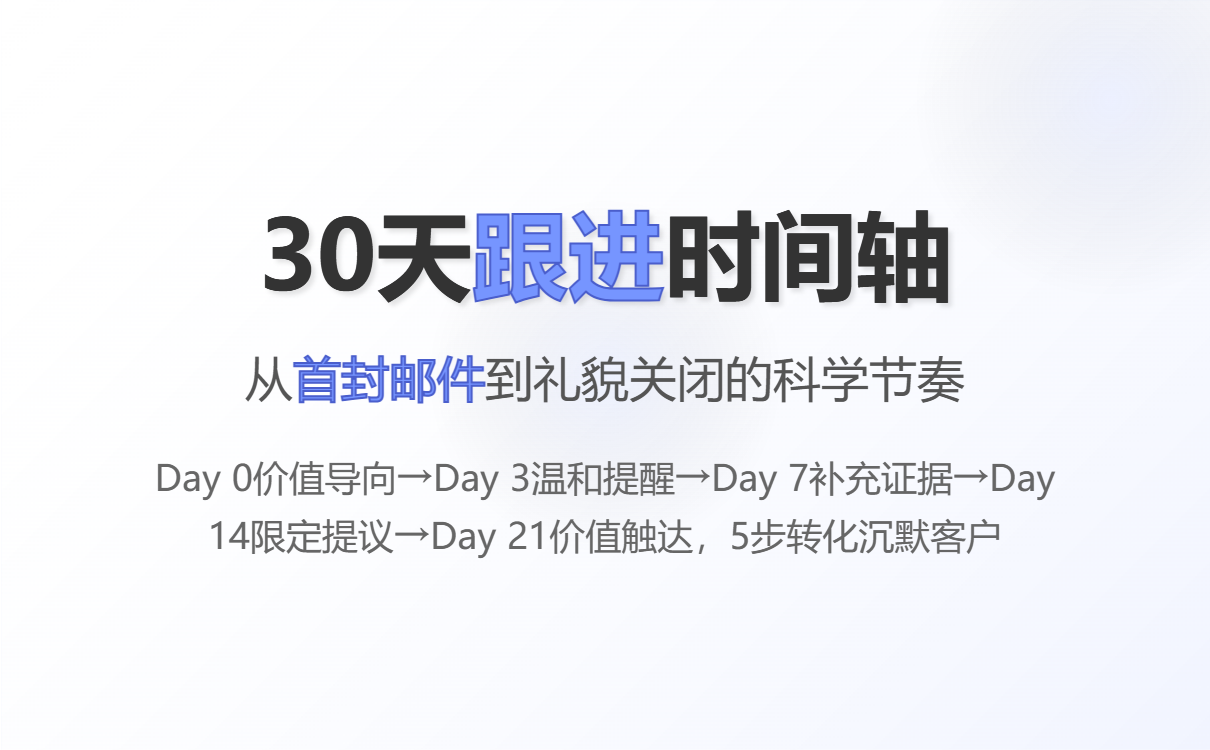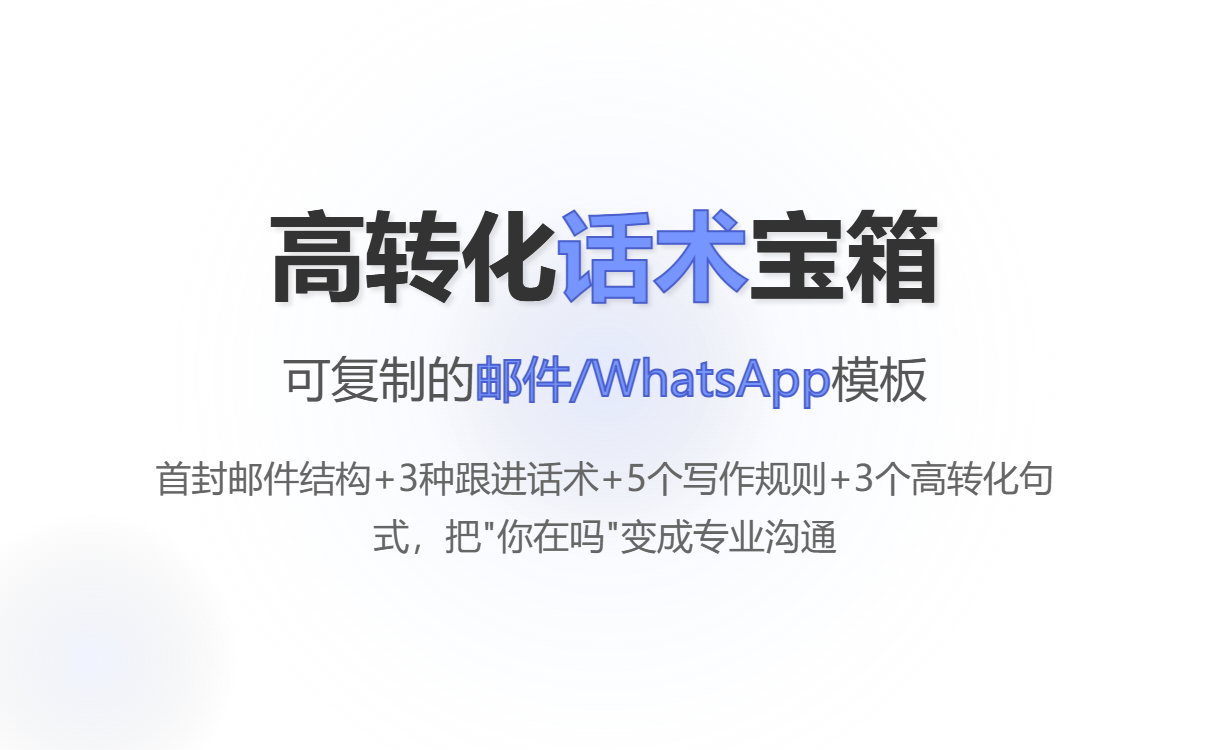
Having worked in foreign trade for over a decade, I've encountered countless instances of unanswered emails, WhatsApp messages, and LinkedIn posts. Don't rush to blame yourself or give up—often, a client's lack of response is a way of evaluating you . Below, I'll break down these common issues from the client's perspective, providing a practical and replicable response process, script templates, and checklist to help you turn seemingly hopeless responses into successful appointments/orders. Related reading: How to follow up when foreign trade clients consistently don't reply or respond? 20 practical guides for high-frequency scenarios!
Newcomers often wonder: Is the client not interested? In most cases, the decision isn't an immediate rejection, but rather an observation: Who are you? Can you solve my problem? What are the risks of a collaboration? Treat every lack of response as an opportunity to address either insufficient information or the need to build trust, and follow up accordingly, chapter by chapter.

Customers will look at: company information, contact information, samples/certificates, payment and delivery records, and past clients (case studies).
My approach (hands-on demonstration):
The first email/information page should clearly list the company's establishment date, major clients, PDF quotation, product certificates, and factory/product photos.
Prioritize "consumer trust points": quick replies, fixed signatures, official website links, and complete LinkedIn profiles.
If the customer does not respond for a long time, I will send third-party supporting evidence (a summary of the factory audit report, a brief evaluation from a previous customer, and transaction screenshots with sensitive information covered).
Customers are judging whether your quoted price is transparent, whether there are any hidden costs, and whether your delivery date is reliable.
My approach:
Quotations should be tiered (MOQ / FOB / EXW / Unit Price / Bulk Discount / Remarks), not a single vague number.
Explaining the cost structure and variables (material price increases, seasonal transportation) makes one appear more professional.
If the customer doesn't reply, proactively send follow-up messages such as "Price validity period" and "Do you need me to requote according to your expected quantity in the near future?" to guide them to respond.
The customer is testing: How fast do you respond? How professional are you? Can you solve technical problems?
My approach:
Please reply within 24-48 hours. If you encounter a technical issue, please confirm receipt and inform us of the expected response time (e.g., I will confirm and give you feedback to my technical engineer today).
If the customer doesn't reply, I will emphasize in my follow-up the fact that "I have consulted the technical team for you," and attach a brief conclusion or attachment.
The customer was concerned that the quality of the sample would not be consistent with that of the mass production.
My approach:
Proactively provide sample procedures and testing standards (such as AQL standards), and sample policies in the quotation (fees/refunds/free samples).
If there is no response, send a "sample process and delivery time" chart to reduce the customer's cognitive cost and guide them to the next step (whether they want/don't want samples).
Customers place great importance on post-delivery risks, returns and exchanges, warranties, and compensation terms.
My approach:
Clearly outlining the return/compensation/warranty process and the division of responsibilities in the contract terms or email demonstrates integrity and professionalism.
When a customer doesn't respond, use short case studies to explain "how we handle similar issues + results" to build a sense of security.

My usual follow-up rhythm (applicable to the first 30 days after initial contact):
Day 0 (First Cover) : Value-oriented + Information Package (Company Introduction, Main Products, Clear Pricing, CTA: Asking for the Points You Care About Most)
Day 3 : Gentle Reminder (SMS/WhatsApp) — “Did you see my email? I can help you with… (give one helpful suggestion)”
Day 7 : Supplementing Evidence (Sample Process/Real Cases/Simple FAQ)
Day 14 : Limited offers (limited-time offers/sample offers/free shipping window) or "Should we close this request? I can transfer resources to other customers" — Use "selection boxes" to facilitate a response.
Days 21-30 : One valuable outreach (industry report summary/relevant holiday stocking reminder/price trends) or politely close the email (maintaining a channel for future communication).
Note: Each follow-up should have a clear purpose (e.g., confirming if samples are needed/following up on a quote/scheduling a video conference), and avoid sending aimless messages like "Are you there?"

Subject: [Product Name] — Quotation and Sample Process (including MOQ & Delivery Time)
text:
Hello, {customer name},
I am [Your Name] from [Company Name]. We mainly focus on [product positioning, e.g., high-precision industrial pumps], and have [number] years of foreign trade experience, having served [two or three industry clients].
Attached: Product information / Price list / Test certificate (PDF).
MOQ: {X}; Delivery time: {Y} weeks; Delivery terms: {FOB/EXW}.
What are your main concerns right now? (A) Price (B) Sample (C) Delivery time/quality? I can create a precise plan based on your options.
I look forward to your feedback.
— {Signature: Name/Position/Company/Mobile Number/Official Website}
Short and valuable:
Hello {name}, I just sent you a detailed quote and certificates to your email. What's your biggest concern right now? I can highlight the key points for you to save you time.
[Name], to help you with a more accurate budget, I can hold your current unit price until this Friday (date) . It may be adjusted after that. Do you need me to issue a formal Proforma Invoice (PI) based on your estimated quantity?
[Name], I see you've been quite busy lately. I'll archive this inquiry for now, and I'm happy to support you anytime you need me. Would it be convenient to let me know if you currently have any purchasing plans? (Yes/No/I'll contact you later)
The topic should be engaging and specific (don't just write "Hello" or "Quote").
The first paragraph addresses the customer's pain points (tell them in one sentence what you can solve).
Clear structure : Key points are presented using short paragraphs or bullet points.
Each email contains a clear CTA (multiple-choice CTAs have high conversion rates, such as "Please select: A/B/C").
The conclusion should include a credible entry point (official website, certificate, customer case link).
Myth: Frequent questioning equates to being proactive.
The truth is: I used to follow up three times a day, and as a result, I was blacklisted. Later, I changed to a "three-step" strategy, and the response rate actually improved.
Misconception: Giving all the materials to the client at once
Authenticity: Clients may experience information overload, so key information should be sent in installments and marked with "This is a key point".
Myth: Prioritizing price and neglecting after-sales service commitments
The truth is: a customer chose me over a cheaper competitor because I clearly stated my after-sales guarantee.
Is the theme clear and engaging?
Does the first paragraph clearly state the customer pain points you can solve?
Are the quotes tiered and do they include an expiration date?
Should we attach 1-2 pieces of evidence of trust (official website/certificate/customer)?
Did you provide a clear and simple next step in your CTA?
Did you follow the timeline settings above for the tracking? (Records available)
If a customer views the product but doesn't reply: Send a small sample of value (such as two high-resolution images/parameter comparison) + a limited-time offer.
Customers never open emails: Send a one-line reminder and a "single-line CTA" on WhatsApp/LinkedIn.
The client suddenly stopped responding (they were very enthusiastic before): I sent a confirmation email and asked if the project was suspended or someone else was taking over.
If a customer remains unresponsive for an extended period but you want to maintain their interest: Send industry-relevant content every 6-8 weeks (do not send content solely for sales purposes).
"I can prepare a formal PI tailored to your quantity for you within 24 hours. Would you like me to continue?"
"To reduce your risk, we can offer an X-day warranty plus a replacement clause for your first order. What do you think?"
"If you don't have any purchasing plans right now, could you tell me when would be a suitable time to follow up? I'll contact you again when it's convenient for you."
Every silence doesn't necessarily mean rejection. It might simply indicate insufficient information, lack of trust, or that the timing isn't right. Think of yourself as a "problem solver" rather than a "price salesperson"—clear, professional, and logical follow-up is more effective than blindly and frequently pressing for payment.
.png?x-oss-process=image/resize,h_100,m_lfit/format,webp)
.png?x-oss-process=image/resize,h_100,m_lfit/format,webp)

.png?x-oss-process=image/resize,h_100,m_lfit/format,webp)
.png?x-oss-process=image/resize,h_100,m_lfit/format,webp)
.png?x-oss-process=image/resize,h_100,m_lfit/format,webp)
.png?x-oss-process=image/resize,h_100,m_lfit/format,webp)
